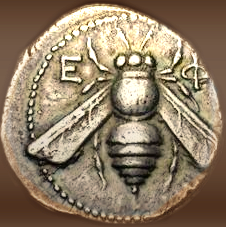Bees have buzzed their way into the mythologies of ancient civilizations, each culture giving them a unique place among their gods and legends.
In Ancient Egypt, bees were thought to be tears of the sun god Ra. Egyptians believed these tiny creatures were divine and symbolized royalty and power. Honey, created by bees, was also extremely prized – not just as a sweet treat, but as a critical element in religious ceremonies and medicine. The Pharaohs were often associated with bees, reinforcing their divine right to rule and their connection to the gods.
Greek mythology has its own fascinating bee tales. Bees were connected to the Muses, the goddesses of arts and sciences, and were seen as bringers of inspiration and knowledge. There’s a charming myth about Aristaeus, the legendary shepherd and protector of bees, who’s credited with teaching humans the art of beekeeping. The Greeks also revered bees as symbols of immortality and resurrection, evident from the gold honeycombs found in ancient tombs.
In Hindu mythology, bees are closely linked to the gods, symbolizing the divine soul, or atman. The bee is seen as a carrier of the soul, and Lord Vishnu is sometimes represented as a blue bee sitting on a lotus flower. The Rigveda, one of the oldest Indian scriptures, even mentions honey as a celestial substance.
Bees weren’t just tiny insects; they represented complex concepts and held deep spiritual significance. This reverence for bees carried through to their essential roles in nature, agriculture, and society. These myths and legends highlight how integral bees were to ancient civilizations, not only in a literal sense but also in their spiritual and cultural lives.
Bees and Folklore Across Cultures
In Celtic traditions, bees were seen as symbols of wisdom and secret knowledge. They were often thought to carry messages between our world and the otherworld, the mysterious land of spirits and gods. Celtic folklore is rich with stories about bees acting as guides or protectors. For instance, it was believed that bees must be informed of major events like births and deaths in a family, or they might leave the hive. This practice is known as “telling the bees.” The Celts saw bees as family members and treated them with great respect.
Native American cultures also have captivating tales about bees. Many tribes viewed bees as symbols of hard work, loyalty, and courage. Bees appeared in stories as creators and problem-solvers. For example, the Hopi people believe in the ‘Bee Woman,’ a deity credited with teaching them to grow crops and live harmoniously. These tales highlight the admiration and respect for the industrious nature of bees.
Eastern European folklore offers another perspective on bees. In countries like Poland and Russia, bees were considered holy and were believed to possess the souls of deceased ancestors. It was customary to whisper secrets or wishes to bees, who acted as intermediaries to the spiritual world. Some traditions held that bees could sense the purity of one’s heart, and their behavior was seen as an omen. For example, a bee entering your home was considered a sign of good fortune, while harming a bee could bring bad luck.
These diverse folklore traditions reveal how deeply humans have connected with bees throughout history. The respect and reverence for bees in these stories mirror how crucial they were (and continue to be) in our everyday lives. They weren’t just seen as insects but as messengers, healers, and guides weaving a significant presence in the fabric of cultural narratives around the world.
Honeybees: Symbols of Industry and Prosperity

Honeybees have long been celebrated for their tireless work ethic and strong sense of community. Many cultures admired how these insects worked harmoniously for the greater good of the hive, embodying qualities like diligence and cooperation. This admiration is evident in countless proverbs and sayings, such as ‘busy as a bee,’ reflecting the relentless effort bees put into their tasks.
In medieval Europe, honeybees were often linked with prosperity and good fortune. They featured prominently in heraldry and family crests, symbolizing hard work and a bountiful harvest. Monasteries kept bees not just for their honey but for the beeswax used in candles, which was essential for worship and daily life. The monks saw bees as tiny models of monastic life, working quietly and efficiently in service of a higher purpose.
Literature and art have continued to uplift the image of the honeybee. Shakespeare used bee imagery to comment on social organization and efficiency in several plays. More recently, children’s books love to portray bees as endearing characters who teach valuable lessons about working together and the importance of community. Bees have buzzed their way into our collective consciousness as symbols of industriousness and the benefits of a strong, unified community.
Even today, the symbolism of the honeybee has found a place in corporate culture and branding. Companies often use bees or hives in their logos to represent reliability, teamwork, and growth. Honey and bees are also frequently used in marketing natural and organic products, capitalizing on their wholesome and hardworking image. This modern interpretation continues to highlight our enduring respect for these incredible insects.
Honey: The Sweet Link to the Divine

Honey has been treasured across cultures not only for its sweetness but for its purported divine properties. This golden elixir was often seen as a gift from the gods, holding a special place in rituals and spiritual practices.
Religious ceremonies frequently included honey as an offering. In Ancient Egypt, honey was presented to deities in temples, and it was a common feature in Hindu rituals where it symbolized purity and health. The Greeks offered honey to their gods and used it in their mysteries, especially in rites honoring deities like Demeter and Apollo. Honey’s association with the divine made it a revered substance in these ancient traditions.
The medicinal benefits of honey further added to its sacred status. Ancient texts from Egypt, China, and India detail various uses of honey as a healing agent. It was believed to have antibacterial properties and was used to treat wounds, digestive issues, and more. In the Middle Ages, honey’s medicinal properties continued to be valued, often being used in concoctions to cure ailments and as a key ingredient in medieval apothecaries.
In many cultures, honey is still symbolic of health and spirituality. Modern holistic practices frequently recommend honey for its natural healing properties. It’s used in rituals and wellness practices aimed at promoting overall health and spiritual cleansing. This ongoing reverence shows that honey continues to be a bridge between the natural world and our spiritual lives.
If you would like to receive the monthly newsletter from Beewhisperer360 drop your email address in the comments section.
